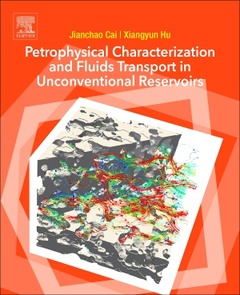Petrophysical Characterization and Fluids Transport in Unconventional Reservoirs
Coordonnateurs : Cai Jianchao, Hu Xiangyun

Petrophysical Characterization and Fluids Transport in Unconventional Reservoirs presents a comprehensive look at these new methods and technologies for the petrophysical characterization of unconventional reservoirs, including recent theoretical advances and modeling on fluids transport in unconventional reservoirs. The book is a valuable tool for geoscientists and engineers working in academia and industry. Many novel technologies and approaches, including petrophysics, multi-scale modelling, rock reconstruction and upscaling approaches are discussed, along with the challenge of the development of unconventional reservoirs and the mechanism of multi-phase/multi-scale flow and transport in these structures.
Part 1 Petrophysical Characterization 1. Characterizing Pore Size Distributions of Shale 2. Petrophysical Characterization of the Pore Structure of Coal 3. Characterization of Petrophysical Properties in Tight Sandstone Reservoirs 4. Multifractal Analysis of Pore Structure of Tight Oil Reservoirs Using Low-Field NMR Measurements 5. Investigation and Quantitative Evaluation of Organic-Related Pores in Unconventional Reservoirs 6. Permeability of Fractured Shale and Two-Phase Relative Permeability in Fractures 7. Pore Structure, Wettability, and Their Coupled Effects on Tracer-Containing Fluid Migration in Organic-Rich Shale 8. Tight Rock Wettability and Its Relationship With Petrophysical Properties
Part 2 Porous Flow Dynamics 9. Flow Mechanism of Fractured Low-Permeability Reservoirs 10. Heat Transfer in Enhanced Geothermal Systems: Thermal-Hydro-Mechanical Coupled Modeling 11. Pore-Scale Modeling and Simulation in Shale Gas Formations 12. High-Pressure Methane Adsorption in Shale 13. Coal Permeability Modeling Considering Nonconstant Vertical Stress Condition 14. Dynamic Gas Flow in Coals and Its Evaluation 15. Multiphysical Flow Behavior in Shale and Permeability Measurement by Pulse-Decay Method
Geologists, Geophysicists, Exploration Geologists, Seismologists, Reservoir engineers and Soil physicists.
Professor Xiangyun Hu, Hubei Subsurface Multi-scale Imaging Key Laboratory, Institute of Geophysics and Geomatics, China. Xiangyun Hu received a Ph.D degree in mineral resource prospecting and exploration from China University of Geosciences (Wuhan) in 2000. Since 2005 he has been a professor in the Institute of Geophysics and Geomatics at the China University of Geosciences (Wuhan). His current research focuses on rock physics, 3D MT/CSAMT/CSEM forward modeling and inverse problems, high performance parallel computation, and geoelectrical characteristics of the Tibetan Plateau, as well as integrated geophysical interpretation. He has published more than 100 peer-refereed journal articles and 3 book chapters.
- Includes both practical and theoretical research for the characterization of unconventional reservoirs
- Covers the basic approaches and mechanisms for enhanced recovery techniques in unconventional reservoirs
- Presents the latest research in the fluid transport processes in unconventional reservoirs
Date de parution : 01-2019
Ouvrage de 352 p.
19x23.3 cm
Thèmes de Petrophysical Characterization and Fluids Transport in... :
Mots-clés :
Petrophysics; unconventional reservoirs; reservoir characterization; multi-scale modelling; rock reconstruction and upscaling approaches; relative permeability; capillary pressure-saturation curve; modelling of multiphase flow; Nuclear magnetic resonance; petrophysical characterization; dynamic modeling of gas flow; pore network modeling; fractal-based approaches; nuclear magnetic resonance; numerical reconstruction and enhanced geothermal systems



